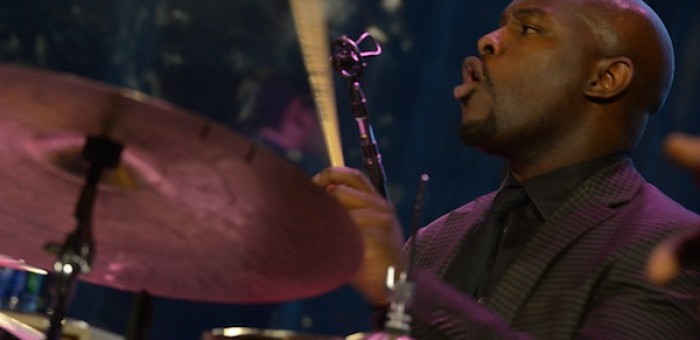Dec 9, 2025 12:28 PM
In Memoriam: Gordon Goodwin, 1954–2025
Gordon Goodwin, an award-winning saxophonist, pianist, bandleader, composer and arranger, died Dec. 8 in Los Angeles.…

Grammy-winning drummer Ulysses Owens Jr. performs at Dizzy’s Club Coca-Cola in New York on April 29.
(Photo: Courtesy of Sunshine Sachs)In a celebration of “Ellington And Beyond,” the immensely talented drummer Ulysses Owens Jr. and his equally brilliant quartet brought a bold, endearing vision of the Duke’s music to Dizzy’s Club Coca Cola in Manhattan on April 29–30 as part of the International Jazz Day festivities.
Owens—a two-time Grammy winner and a familiar name to DownBeat readers—has shared Dizzy’s stage over the past few years with such luminaries as bassist Christian McBride, saxophonist Steve Wilson, vibraphonist Steve Nelson and piano prodigy Joey Alexander.
Owens has taken on big, bold projects in the past. Last year, he debuted his work “Ulysses In 3” at New York’s Park Avenue Armory, exploring the work of choreographer Ulysses Dove, the novel Ulysses by James Joyce and his own compositions.
In July, Owens debuted his seven-movement suite Stages Of Us in the Museum of Modern Art’s sculpture garden as part of the institution’s “Summergarden Series.”
Owens has built a reputation as a creative collaborator but he also excels in the role of bandleader. Indeed, his directorial prowess gleamed brightly at Dizzy’s, with a top-flight ensemble consisting of bassist Yasushi Nakamura, “King of D.C. piano” Allyn Johnson and the alternating talents of Jazz at Lincoln Center Orchestra members Marcus Printup (trumpet) and Ted Nash (saxophone). The Friday evening show celebrated Duke Ellington’s birthday of April 29, 1899.
Owens kicked off the proceedings with a furious rudimental drum solo, recalling drumming master Kenny Washington. The other musicians soon jumped into the fast lane with Owens, Nash releasing a Bird-fired solo of heated squalls and hard high notes followed by a graceful descent.
Printup’s lyrical trumpet solo brought out Owens’ brushes, and the soup was furiously stirred. Owens provided considerable sonic girth to Printup’s solo, loud bass drum jabs driving the entire quartet. Johnson’s solo—a knife-edged piano workout—was followed by Owens’ closing solo, a speed demon display of power rolls, unison sticking thrills and drilling bass drum assaults.
A version of Ellington and Billy Strayhorn’s “U.M.M.G. (Upper Manhattan Medical Group)” and an atypical version of “Mood Indigo” followed. As Nakamura opened this “Indigo” with an extended bass solo, he was supported by Owens’ graceful mallet work. The song’s melody, conveyed through clarinet and trumpet, took on a happy, urbane bent, like music to accommodate a Sunday stroll in your finest dress.
The quartet’s traditional “Zip-A-Dee-Doo-Dah” vibrated around the club like fairy dust, inspiring audience members to tap their feet and snap their fingers. With its instrumental-fire-meets-studied-tradition template set, the quartet then entertained the crowd of Manhattanites and tourists with some salty Afro-Cuban rhythms. Owens adjusted his focus appropriately, laying out an extroverted rhythm of clanging cowbell, booming tom tom and popping cymbal accents, literally quoting the melody of “Take The ‘A’ Train.”
Once locked into a pocket, Johnson unleashed a chunky solo, the rhythm section supporting his notes with a groove big enough to drive a Cadillac through. Suddenly the band was blazing. Owens’ brushes sizzled, and the song’s conclusion was met with loud applause.
After an unusual rendition of Ellington’s “On A Turquoise Cloud,” performed by soprano Candice Hoyes (whose album of the same name was produced by Owens), the quartet performed “The Star Crossed Lovers” with Nash delivering a beautiful Johnny Hodges-worthy solo complimented by non-Hodges friendly squeaks.
Owens’ group closed with a dramatically arranged “It Don’t Mean A Thing” that was initially unrecognizable. Spreading the melody over the instruments in straight time, cut-time then double-time, the music flew like a missle, driven by Owens’ head-slamming single-stroke rolls and final, walloping bass-drum accents.

Goodwin was one of the most acclaimed, successful and influential jazz musicians of his generation.
Dec 9, 2025 12:28 PM
Gordon Goodwin, an award-winning saxophonist, pianist, bandleader, composer and arranger, died Dec. 8 in Los Angeles.…

Flea has returned to his first instrument — the trumpet — and assembled a dream band of jazz musicians to record a new album.
Dec 2, 2025 2:01 AM
After a nearly five-decade career as one of his generation’s defining rock bassists, Flea has returned to his first…

Belá Fleck during an interview with Fredrika Whitfield on CNN.
Jan 13, 2026 2:09 PM
The fallout from the renaming of the John F. Kennedy Center for the Performing Arts to include President Donald…

“It’s a pleasure and an honor to interpret the music of Oscar Peterson in his native city,” said Jim Doxas in regard to celebrating the Canadian legend. “He traveled the world, but never forgot Montreal.”
Nov 18, 2025 12:16 PM
In the pantheon of jazz luminaries, few shine as brightly, or swing as hard, as Oscar Peterson. A century ago, a…

Dec 11, 2025 11:00 AM
DownBeat presents a complete list of the 4-, 4½- and 5-star albums from 2025 in one convenient package. It’s a great…